ST. PATRICK’S CORNED BEEF SHORT RIBS
TODAY’S LESSON: The celebration of St. Patrick’s Day and the “wearing of the green” is just around the corner! St. Patrick’s Day celebrates the heritage of Ireland with shamrocks, green beer, and traditional Irish foods like corned beef and cabbage, soda bread, and Irish stew. To commemorate St. Pat’s Day this year, we will modernize the traditional corned beef by substituting super silky short ribs for the best-corned beef ever!
WHERE DOES CORNED BEEF COME FROM? The term “corned beef” originated during the time Anglo-Saxon tribes traversed Britain. With long sojourns and short stops a way of life for these tribes, it was necessary to find a way to have the mainstays of their diets readily available. Their meat was cured to prolong it’s “life” and prevent spoilage. The process of curing was done in rock salt that was crushed to the size of wheat kernels, commonly called”corns”. Therefore, the name “corned” stuck hard to this preparation. This method as a curative for meats and fish was displaced by the onset of refrigeration.
WHERE DOES CORNED BEEF COME FROM? Corned beef traditionally utilizes the brisket or breast of the cow, a cut composed of two overlying muscles called the brisket top point and lower flat. Connective tissue runs between the muscles and needs to be cooked to tenderize or removed prior to serving. Read more on Brisket on FoodShed Exchange.
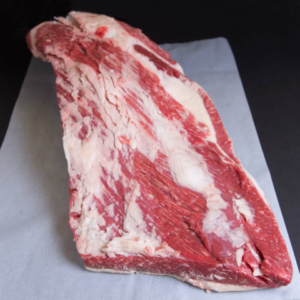
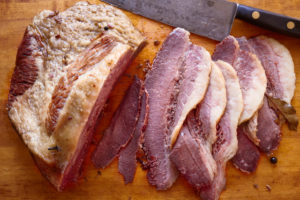
The Top Point of the brisket point makes up 30% of the brisket. The point is a lump of meat that partially overlaps one end of the flat. It is quite fatty on its surface as well as within the meat. It also contains a lot of connective tissue between the meat fibers. It can be sliced, but its loose texture after cooking makes it a better choice for chopped brisket sandwiches or burnt ends.
The Lower Flat of the brisket accounts for 70% of the brisket. The flat is just that: Sort of a flat, rectangular piece of meat that makes up the majority of the whole brisket. This is the portion that is sliced across the grain and served on a plate or in a sandwich. You’ve probably seen the flat in the meat case at the supermarket, separated from the point and with most fat removed, ready for braising in the oven.
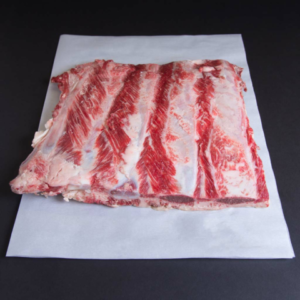 WHERE DO SHORT RIBS COME FROM?
WHERE DO SHORT RIBS COME FROM?
The short ribs, on the other hand, are a little higher up on the cow and more
tender. Short ribs are a “created” cut of beef from the primal chuck and short plate
of the cow, typically, not consisting of more than five ribs. The “ribs” are
cut 2 to 3 inches long and are layered with fat, meat and bone. My favorite is the chuck short ribs which are the lower muscle area of the rib structure, specifically 5 ribs in the Chuck area. They have good marbling with a thinner fat cap than the short plate short ribs.
Read more on Chuck Short Ribs on FoodShed Exchange…
Read more on Short Plate Short Ribs on FoodShed Exchange…
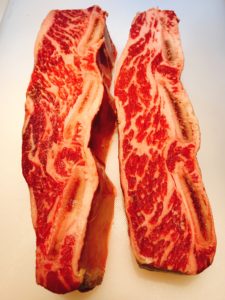

CUT THE SHORT RIBS: The typical short rib cut with the bone can be a huge 8 to 12-ounce portion, often tied to keep intact in one piece. A Flacken cut short rib is cut against the length of the bone as shown here. Cut the short ribs again between the bone to produce sections of meat with one bone for easier handling and serving.
CURING THE SHORT RIBS INTO CORNED BEEF: The traditional curing procedure takes at least a week up to a month in brine to turn the simple beef breast into corned beef. We will shortcut that process with a short marinade followed by spicing the braising liquids.
WHAT MAKES CORNED BEEF KEEP ITS RED COLOR? The secret to the “corned beef color” is the curing salt which is used to retard bacterial growth during the curing time and also set the color of the meat or sausage. There are a couple of primary curing salts that are colored pink to prevent confusion with regular salts:
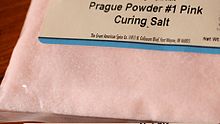 Pink curing salt #1(Prague Powder #1) which contains 6.25% sodium nitrite and 93.75% table salt, used for meats that require short cures and quickly consumed.
Pink curing salt #1(Prague Powder #1) which contains 6.25% sodium nitrite and 93.75% table salt, used for meats that require short cures and quickly consumed.
Pink curing salt #2 (Prague Powder #2) which contains 6.25% sodium nitrite, 4% sodium nitrate, and 89.75% table salt, used for meats and sausages with longer curing time allowing the nitrates to break down to nitrites and eventually dissipate.
For the “natural” approach use celery juice powder which contains vegetable-based nitrites.
SKIP THE NITRATES-BETTER FOR YOUR HEALTH: Since we are not brining over time we really don’t need the curing salts. I prefer the color and flavor of sweet paprika in the spice mix to enhance the color.
TIME TO COOK – WHAT EXACTLY IS BRAISING? Braising is a slower cooking method that allows the full flavor of the meat to come through by utilizing “wet” heat. Similar to boiling, braising allows the process of wet cooking to be accomplished at lower temperatures in the oven rather than on top of the stove. The cooking does, however, begin on top of the stove by searing the seasoned meat over high heat in a large skillet to develop the fullest flavor. Once seared on all sides, stock and vegetables, if desired, are added to the skillet, it is covered with aluminum foil and placed in the oven to cook at the low temperature until ready to serve.
ADVANTAGES: The longer cooking time allows the connective tissue and fat in the short ribs to break down resulting in tender meat that is rich in flavor but not necessarily rich in fat meat.
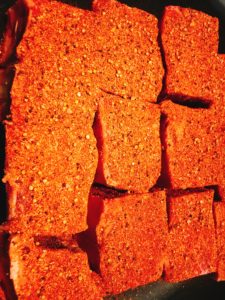
MARINADING THE SHORTRIBS: In a medium saucepan combine the water, salt, sugar, and spices, then bring to a boil. Remove the brine from the heat and allow to cool to room temperature. Place the short ribs in a properly sized baking dish, cover with the marinade, wrap and refrigerate overnight.
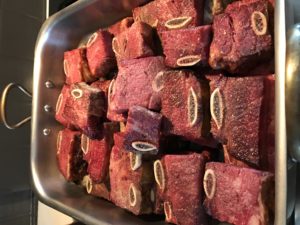
BROWNING YOUR SHORT RIBS: To start the braising, brown the entire seasoned surface of the meat on top of the stove in a large skillet over high heat. This flavor development by searing is crucial as the cooking temperature during braising never exceeds 212 degrees F.
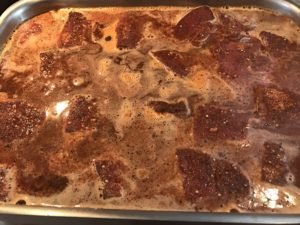
COVER WITH SEASONED LIQUIDS: Although corned beef uses just water seasoned with spices, the short ribs may be enriched with a good stock. Use the spices of crushed red pepper, peppercorns, allspice, mustard seed, caraway, and bay leaves to season the liquids along with a little salt.
IT MUST BOIL! Bring the meat, vegetables, and stock to a full boil before covering the surface of the liquid with aluminum foil and placing in the oven. This starts the cooking process quickly and allows the cooking to continue without a total heating of the skillet and its contents as it enters the oven.
TRICKS OF THE TRADE: Covering the surface of the braising liquid with aluminum foil(dull side up) prevents the contents of the skillet from boiling and will result in more tender meat.
THE COOKING BEGINS: Braising takes time, anywhere from 1-1/2 to 2 hours, from the point at which the boiling on top of the stove begins until tender. You can best test for doneness by inserting a skewer into the meat. It is done if, when removed, it meets no resistance.
ONCE ITS DONE: It is important to allow the meat to rest and cool in the stock until just warm. Patience on your part and following this step will produce the moistest and tender results. To serve, return the skillet to the heat.
TRY YOUR TECHNIQUE: You have to try Corned Beef Short Ribs to celebrate your St. Patrick’s Day.
CORNED BEEF SHORT RIBS
Makes 4 servings
The corned beef brine
2 quarts cold water
1 cup coarse sea salt
1 cup brown sugar
4 tablespoons whole black peppercorns
4 tablespoons whole allspice
1/4 cup whole mustard seeds
1/4 cup caraway seeds
1/4 cup sweet paprika
4 bay leaves
4 whole cloves
4 beef short ribs, tied lengthwise, about 8 ounces each Or flanken cut into 4-ounce sections as shown above
The braising process
4 tablespoons unsalted butter or olive oil
1 medium-size onion, diced
4 cups Stock or water
salt to taste
freshly ground black pepper to taste
1/4 cup prepared white horseradish
1/4 cup chopped parsley
4 cups green cabbage, shredded fine
4 sprigs fresh parsley for garnish
In a large pot combine the water, salt, sugar and half of the spices. Bring to a boil over high heat, then turn off and allow to cool to room temperature. Place the short ribs in a properly sized baking dish and cover with the marinade. Cover the dish with plastic wrap and refrigerate overnight.
Preheat the oven to 375 degrees F.
In a large ovenproof skillet, melt 2 tablespoons of the butter over high heat. Add the short ribs and brown on all sides. Transfer to a warm plate and set aside. Add the onions and saute until browned, about 5 minutes. Return the short ribs to the skillet, the stock, and the remaining spices. Bring to a boil. Add the salt and pepper to taste. Float a sheet of aluminum foil, dull side
down, on the surface of the stock. Cover the skillet with a lid, place on the lower rack of the oven, and cook until tender, about 2 hours. The short ribs are done when a skewer inserted into the thickest section of the meat can be removed without resistance; don’t be afraid to continue cooking until they become this tender.
Remove 1 1/2 cups of the stock to a small saucepan. Bring to a simmer over high heat and cook until it is thickened enough to coat the back of a spoon, about 6 minutes. Add the horseradish and parsley, then transfer to a blender. Puree until smooth, about 30 seconds. Adjust the salt and pepper.
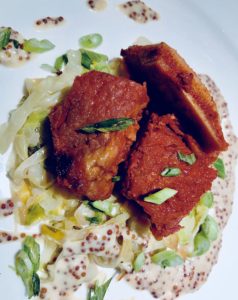 Meanwhile, in a large nonstick skillet heat the remaining butter. Add the cabbage cooking while tossing until wilted and tender, about 5 minutes. season generously with salt and pepper. Divide and mound the cabbage to the center of your large serving coupe bowls. Transfer the short ribs to atop the cabbage. Remove the string. Spoon the. horseradish sauce over, garnish with parsley sprigs and serve.
Meanwhile, in a large nonstick skillet heat the remaining butter. Add the cabbage cooking while tossing until wilted and tender, about 5 minutes. season generously with salt and pepper. Divide and mound the cabbage to the center of your large serving coupe bowls. Transfer the short ribs to atop the cabbage. Remove the string. Spoon the. horseradish sauce over, garnish with parsley sprigs and serve.